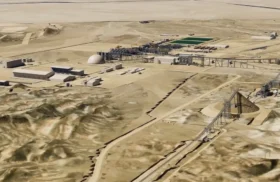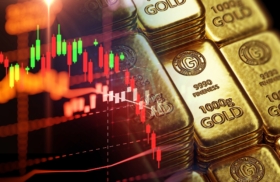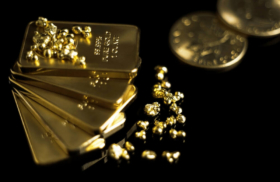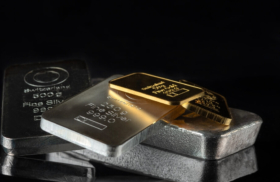Gold

June 17, 2025
IFC Provides $400 Million Subordinated Loan for Pakistan’s Reko Diq Copper-Gold Megaproject
The International Finance Corporation has committed an additional $400 million subordinated loan to Barrick Gold’s Reko Diq copper-gold project in Pakistan, bringing the World Bank Group’s total financing commitment to $700 million for what is expected to become one of the world’s largest copper mines. The loan, announced June 13, supports the project’s total estimated...
READ MORE
May 19, 2025
Gold Hovers Near $3,240/oz as Rebound Stalls; Analysts See Bearish Signals Emerging
BY John Davis
Spot gold traded at around $3,239 per ounce in early Asian hours on Wednesday, after a modest recovery on Tuesday that saw prices close 0.46% higher at $3,249.90/oz. The rebound came after a more than 2.7% drop on Monday but may be short-lived, according to analysts. Christian Borjon Valencia of FXStreet noted that Tuesday’s rally...
READ MORE
April 24, 2025
Japan Gold Begins Drilling at Hakuryu Project in Barrick Alliance, Targeting High-Grade Gold on Hokkaido
Japan Gold has commenced its initial drill program at the Barrick Alliance Hakuryu Project in Hokkaido, Japan, marking the start of its 2025 exploration campaign. The company is targeting the Hakuryu No. 3 Vein, with plans to drill up to four shallow holes from two sites, totaling 700 meters. Assay results are expected in the...
READ MORE
April 24, 2025
Fresnillo Reaffirms Multi-Year Outlook Despite Quarterly Drop in Gold and Silver Output
BY Lara Browne
Fresnillo has reaffirmed its production guidance for 2025 and the following two years, even as the Mexico-focused precious metals producer reported a quarterly decline in both gold and silver output due to lower ore grades and the cessation of mining at key sites. The company’s first-quarter results showed attributable gold production rose 11% year-on-year, largely...
READ MORE
April 22, 2025
Zijin Mining Acquires Akyem Mine, Advances to Top Six in Global Gold Rankings
BY Lara Browne
Zijin Mining has completed the acquisition of the Akyem gold mine in Ghana, further cementing its status as a major global gold producer. The deal strengthens Zijin’s growing gold portfolio, which already includes key assets such as the Rosebel and Aurora mines, and supports the company’s goal of surpassing 100 tonnes of mined gold annually...
READ MORE
April 22, 2025
Precious Metals Markets Surge Amid Tariffs, Inflation, and Geopolitical Tensions
BY John Davis
The Global Precious Metals MMI (Monthly Metals Index) posted an 8% month-over-month gain, reflecting a period of intense volatility for the U.S. precious metals market. Over the past five weeks, prices have been pulled in different directions by persistent inflation, shifting interest rate expectations, new tariffs, and escalating geopolitical risks. These forces have driven dramatic...
READ MORE
April 18, 2025
ALROSA Expands Into Polymetals and Gold Amid Diamond Market Uncertainty
Russia’s state-run diamond miner ALROSA is expanding its exploration and development efforts beyond diamonds, citing signs of polymetal occurrences in Yakutia and a broader push into gold mining. The company plans to evaluate the commercial potential of these additional resources, aiming to list them on its balance sheet. Company head Pavel Marinychev confirmed during the...
READ MORE
April 18, 2025
Gold Prices Climb as Tariff Concerns and Weak Dollar Drive Safe-Haven Demand
BY Lara Browne
Gold prices rose on Tuesday, buoyed by investor uncertainty over U.S. trade policy and a declining dollar, as market participants continued to seek refuge in safe-haven assets. Spot gold increased 0.6% to $3,230.18 per ounce by mid-afternoon in New York, just shy of the record high of $3,245.42 set on Monday. U.S. gold futures settled...
READ MORE
April 18, 2025
Krastsvetmet Grows Gold Output but Loses Market Share Amid Rising National Production
Krastsvetmet boosted its refined gold production to 198 tonnes in 2024, marking a 9.4% increase compared to the previous year, according to recently published data. Despite the rise in output, the company’s dominance in the Russian gold refining sector slipped, with its market share dropping by 1 percentage point to 55%. The decline in market...
READ MORE
April 18, 2025
Top Copper Suppliers Urge U.S. to Avoid Tariffs, Warn of Global Repercussions
Chile, Canada, and Peru — the three largest suppliers of copper to the United States — have formally urged the Trump administration to avoid imposing tariffs on copper imports, arguing that their shipments pose no threat to U.S. national security and are essential to the country’s industrial supply chain. The appeals come in response to...
READ MORE